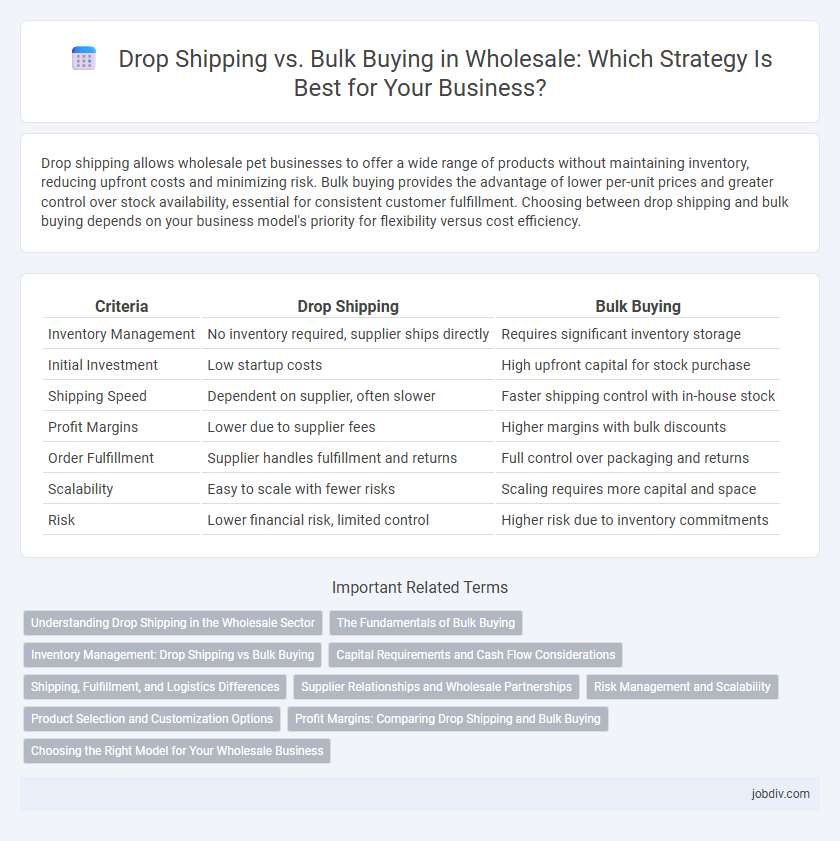Drop shipping allows wholesale pet businesses to offer a wide range of products without maintaining inventory, reducing upfront costs and minimizing risk. Bulk buying provides the advantage of lower per-unit prices and greater control over stock availability, essential for consistent customer fulfillment. Choosing between drop shipping and bulk buying depends on your business model's priority for flexibility versus cost efficiency.
Table of Comparison
| Criteria | Drop Shipping | Bulk Buying |
|---|---|---|
| Inventory Management | No inventory required, supplier ships directly | Requires significant inventory storage |
| Initial Investment | Low startup costs | High upfront capital for stock purchase |
| Shipping Speed | Dependent on supplier, often slower | Faster shipping control with in-house stock |
| Profit Margins | Lower due to supplier fees | Higher margins with bulk discounts |
| Order Fulfillment | Supplier handles fulfillment and returns | Full control over packaging and returns |
| Scalability | Easy to scale with fewer risks | Scaling requires more capital and space |
| Risk | Lower financial risk, limited control | Higher risk due to inventory commitments |
Understanding Drop Shipping in the Wholesale Sector
Drop shipping in the wholesale sector allows retailers to sell products without maintaining inventory by partnering with suppliers who ship orders directly to customers. This method reduces upfront costs and inventory risks, making it ideal for businesses testing new markets or products. Efficient supplier relationships and real-time inventory updates are critical to ensuring seamless order fulfillment and customer satisfaction in drop shipping.
The Fundamentals of Bulk Buying
Bulk buying in wholesale involves purchasing large quantities of products at discounted rates, reducing per-unit costs and increasing profit margins. It requires efficient inventory management and upfront capital investment but offers better control over stock and shipping times compared to drop shipping. Businesses often prefer bulk buying to leverage supplier relationships and negotiate favorable terms for long-term growth.
Inventory Management: Drop Shipping vs Bulk Buying
Drop shipping allows businesses to manage inventory without holding stock, reducing overhead costs and minimizing risks associated with unsold products. Bulk buying requires upfront investment in large quantities, necessitating efficient warehouse management and accurate demand forecasting to avoid excess inventory or stockouts. Effective inventory management in bulk buying can improve profitability through volume discounts, while drop shipping offers flexibility and scalability by transferring inventory control to suppliers.
Capital Requirements and Cash Flow Considerations
Drop shipping requires minimal capital investment since inventory is not purchased upfront, improving cash flow management by reducing storage and handling costs. Bulk buying demands significant upfront capital to stock large quantities, which can strain cash flow but often secures lower per-unit costs and higher profit margins. Understanding these financial dynamics is crucial for wholesalers optimizing operational efficiency and growth strategies.
Shipping, Fulfillment, and Logistics Differences
Drop shipping eliminates the need for inventory storage by shipping products directly from suppliers to customers, reducing warehousing costs but potentially increasing shipping times and complexity in order tracking. Bulk buying requires managing large inventory volumes, demanding extensive fulfillment centers and streamlined logistics to handle packing, shipping, and returns efficiently. Shipping costs tend to be lower per unit in bulk buying due to consolidated shipments, while drop shipping often incurs higher per-order shipping fees and relies heavily on supplier reliability for fulfillment accuracy.
Supplier Relationships and Wholesale Partnerships
Effective supplier relationships in drop shipping prioritize real-time inventory updates and seamless order fulfillment, reducing overhead and storage costs for retailers. Bulk buying fosters deeper wholesale partnerships through negotiated pricing, volume discounts, and reliable supply chains, enabling long-term collaboration and consistent product availability. Both models require transparent communication and trust to optimize supply chain efficiency and meet customer demand in wholesale markets.
Risk Management and Scalability
Drop shipping minimizes financial risk by eliminating the need for inventory investment, allowing businesses to scale quickly without significant upfront costs. Bulk buying offers greater control over product quality and supply chain reliability but requires substantial capital and carries higher inventory risks. Effective risk management in wholesale hinges on balancing these models to optimize scalability while minimizing exposure to market fluctuations and stock obsolescence.
Product Selection and Customization Options
Drop shipping offers a vast product selection without upfront inventory costs, allowing retailers to test trending items quickly and adjust their catalogs dynamically. Bulk buying provides opportunities for extensive product customization, including private labeling and packaging tailored to brand identity, which enhances customer loyalty and perceived value. Choosing between drop shipping and bulk purchasing depends on balancing flexibility in product range with the desire for personalized offerings and control over inventory.
Profit Margins: Comparing Drop Shipping and Bulk Buying
Drop shipping offers lower upfront costs and reduces inventory risks but typically yields thinner profit margins compared to bulk buying. Bulk buying enables wholesalers to capitalize on volume discounts, significantly increasing profit margins by lowering per-unit costs. Strategic inventory management in bulk buying further amplifies profitability through optimized storage and logistics expenses.
Choosing the Right Model for Your Wholesale Business
Selecting the ideal wholesale model requires evaluating factors such as inventory management, cash flow, and customer demand. Drop shipping eliminates the need for warehouse storage by shipping products directly from suppliers, reducing upfront costs but often yielding lower profit margins. Bulk buying demands higher initial investment and storage capabilities but provides greater control over stock and potentially higher profitability through volume discounts.
Drop Shipping vs Bulk Buying Infographic

 jobdiv.com
jobdiv.com